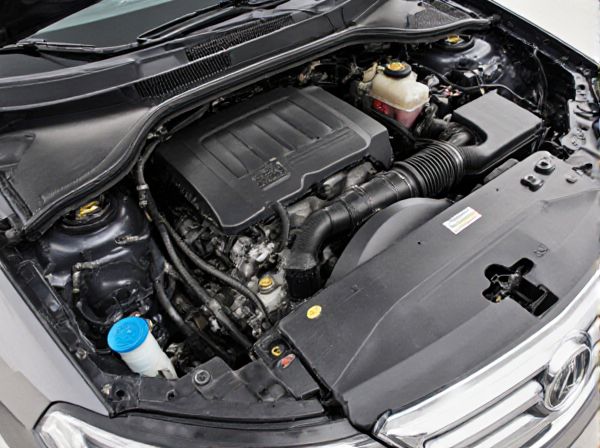
Photo illustration: Crankcase Ventilation (Open) vs Crankcase Ventilation (Closed)
Open crankcase ventilation systems release blow-by gases directly into the atmosphere, which can lead to increased pollution and loss of engine efficiency. Closed crankcase ventilation systems route these gases back into the combustion chamber, reducing emissions and improving engine performance. Understanding the differences helps you choose the right setup for better environmental compliance and optimal engine function.
Table of Comparison
| Feature | Crankcase Ventilation (Open) | Crankcase Ventilation (Closed) |
|---|---|---|
| System Type | Open to atmosphere | Sealed, reroutes gases |
| Emissions Control | Higher emissions, releases blow-by gases | Reduces emissions by recycling blow-by gases |
| Engine Performance | Potential contamination, less efficient | Improved combustion, better efficiency |
| Environmental Impact | Increased pollution | Lower environmental footprint |
| Maintenance | Requires frequent inspection to avoid leaks | Lower maintenance due to sealed design |
| Common Usage | Older or basic engine models | Modern engines, emissions regulated vehicles |
Introduction to Crankcase Ventilation
Crankcase ventilation is essential for maintaining engine performance and reducing harmful emissions by managing blow-by gases trapped in the crankcase. Open crankcase ventilation systems vent these gases directly into the atmosphere, while closed systems reroute them back into the engine intake for combustion. Closed systems offer superior environmental compliance and improved engine efficiency by minimizing hydrocarbon emissions and maintaining optimal pressure balance within the crankcase.
Overview of Open Crankcase Ventilation Systems
Open crankcase ventilation systems expel blow-by gases directly into the atmosphere through a vented valve cover or breather cap, which can lead to increased emissions and environmental pollution. These systems are simpler and less costly but lack the efficiency of capturing and recycling crankcase gases, potentially allowing dirt and moisture to enter the engine. Open ventilation designs are commonly found in older engines and applications where emission control standards are less stringent compared to closed crankcase ventilation systems that redirect gases back into the intake manifold for combustion.
Overview of Closed Crankcase Ventilation Systems
Closed crankcase ventilation systems efficiently capture blow-by gases within the engine, rerouting them back into the intake manifold for combustion, reducing harmful emissions and preventing oil contamination. These systems maintain a sealed environment, minimizing the release of pollutants and increasing engine efficiency by controlling crankcase pressure. Closed ventilation promotes compliance with stringent environmental regulations by significantly lowering hydrocarbon emissions compared to open systems.
Key Differences Between Open and Closed Systems
Crankcase ventilation systems are essential for controlling engine blow-by gases and maintaining optimal performance. Open crankcase ventilation systems release blow-by gases directly into the atmosphere, resulting in higher emissions and potential environmental impact, whereas closed systems route these gases back into the intake manifold to be burned, reducing emissions and improving fuel efficiency. Closed systems also prevent oil contamination and maintain better engine pressure balance compared to open systems.
Emissions and Environmental Impact
Open crankcase ventilation systems release blow-by gases directly into the atmosphere, increasing hydrocarbon emissions and contributing to air pollution. Closed crankcase ventilation systems redirect these gases back into the engine intake for combustion, significantly reducing volatile organic compounds (VOCs) and particulate matter emissions. Implementing closed systems aligns with stricter environmental regulations and helps improve overall air quality by minimizing harmful emissions from internal combustion engines.
Engine Performance and Efficiency Considerations
Open crankcase ventilation systems release blow-by gases directly into the atmosphere, resulting in lower backpressure and reduced engine stress but increased emissions and potential loss of fuel efficiency. Closed crankcase ventilation recirculates blow-by gases back into the intake manifold, enhancing combustion efficiency, reducing harmful emissions, and maintaining optimal engine performance through better crankcase pressure control. Modern engines favor closed systems for improved fuel economy, reduced oil contamination, and compliance with stringent emission standards.
Maintenance Requirements and Longevity
Open crankcase ventilation systems require more frequent maintenance due to exposure to dirt and moisture, which can accelerate wear and clogging of components. Closed crankcase ventilation systems offer improved longevity by recycling gases back into the intake manifold, reducing contamination and minimizing oil sludge buildup. Proper upkeep of closed systems typically extends engine life and decreases the need for frequent oil changes compared to open systems.
Compliance With Modern Emission Standards
Closed crankcase ventilation systems comply better with modern emission standards by capturing blow-by gases and routing them back to the engine for combustion, significantly reducing hydrocarbon and particulate emissions. Open crankcase ventilation vents blow-by gases directly into the atmosphere, failing to meet stringent environmental regulations and causing higher pollutant release. Regulatory bodies like the EPA and CARB mandate closed systems in modern vehicles to ensure reduced emissions and improved air quality compliance.
Application Suitability: Open vs. Closed Systems
Open crankcase ventilation systems are typically suited for older engines and low-performance applications where simple emissions control is sufficient, allowing blow-by gases to vent directly into the atmosphere. Closed crankcase ventilation systems are preferred in modern, high-performance, and environmentally regulated vehicles as they recirculate blow-by gases back into the intake manifold, reducing emissions and improving engine efficiency. The closed system's capability to maintain negative pressure within the crankcase also prevents oil leaks and contamination, making it more suitable for advanced automotive engines.
Conclusion: Choosing the Right Crankcase Ventilation System
Selecting the appropriate crankcase ventilation system hinges on vehicle type and environmental regulations, with closed systems providing superior emission control by recycling gases back into the intake manifold. Open crankcase ventilation offers simplicity and cost-effectiveness but allows unfiltered gases to vent into the atmosphere, increasing pollution. For long-term engine health and compliance with stringent emission standards, closed crankcase ventilation systems are generally the optimal choice.
 caratoz.com
caratoz.com